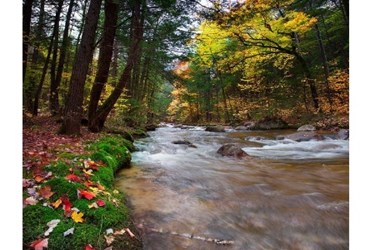New Guidance To Protect America's Water And Reduce Costs With Natural Infrastructure

New Publication Identifies Opportunities from Maine to Washington for Investing in Forests as Low-Cost Options to Ensure Clean Water
A group of water experts has released new guidance for U.S. resource managers to expand the availability of clean water through the conservation and restoration of forests and other natural infrastructure. The publication, Natural Infrastructure: Investing in Forested Landscapes for Source Water Protection in the United States, builds on several innovative efforts across the United States and provides real world examples where water managers are saving money by investing in natural infrastructure.
“Drawing on experts that span the water and land management fields, we set out to provide a roadmap to build on the growing movement of those who champion natural infrastructure efforts in their watersheds,” said Todd Gartner, senior associate at WRI and lead editor of the publication. “This guide can be a go-to resource for water leaders across the United States.”
Cities and towns across the United States are facing growing water challenges. Aging water infrastructure, increasing demand, continued land use change, and extreme weather events are driving up the costs of water management. Water challenges strain public budgets, limit productive economic development, and threaten public health. Resolving these issues is essential for community health and well-being across the United States.
Led by the World Resources Institute in collaboration with Earth Economics and Manomet Center for Conservation Sciences, the publication outlines the economics and science of natural infrastructure investments and identifies opportunities across the country, with key lessons for program design and implementation. The publication is the most comprehensive of its kind to date, convening the expertise of 56 authors spanning the stakeholder groups that need to be involved for natural infrastructure efforts to be successful.
“Natural infrastructure has long been recognized by state drinking water administrators as a powerful and sustainable approach for protecting sources of drinking water and thereby, public health,” said Jim Taft, Executive Director of the Association of State Drinking Water Administrators. “This guide will be of considerable value to states by providing comprehensive information about innovative tools that will help bring the use of natural infrastructure approaches to scale.”
In addition to detailed guidance, Natural Infrastructure provides a look at the current state of practice of natural infrastructure approaches, showing ample opportunity and an expanding toolkit for securing forests for water. For example:
- In Colorado, after the devastating 2002 Hayman fire that cost $26M to manage the water quality impacts alone, Denver Water committed $16.5M in matching funds, alongside the U.S. Forest Service, to implement catastrophic wildfire risk mitigation measures, like prescribed burning and mechanical thinning.
- In Maine, the board of the Portland Water District recently voted unanimously to dramatically scale up investments in conservation easements (up to 25 percent of the conservation value) in its rapidly developing watershed. While Portland continues to enjoy high quality source water, the city can maintain its high standards and avoid treatment costs by securing its forested watershed.
- The city of Raleigh, North Carolina, has allocated $7.5M since 2005 for strategic land conservation to help address declining water quality in its primary reservoir. Working together, land trusts, landowners, municipalities and other government agencies have used voluntary measures to protect over 6,000 priority acres along 63 miles of stream in Raleigh’s watershed.
“Natural infrastructure, with its capacity to absorb rainfall and filter out pollutants and sediment, while providing natural amenities for ratepayers and citizens, is an effective approach to reducing treatment costs and deferring - if not avoiding - significant capital investments over time,” said G. Tracy Mehan, III, former US EPA Assistant Administrator for Water. “WRI’s new publication is a tremendous contribution to the emerging literature and practice in this exciting area of water management.”
“Water utility boards often understand dollars and concrete better than they understand habitat and hydrology. So advocating for natural infrastructure investment can be a challenge in the face of competing infrastructure needs your board is considering,” Paul Hunt, Environmental Manager for the Portland Water District (Maine) said. “This guide provides examples of approaches that are working, descriptions of why and how they work, and the names of contacts who can provide more information so you can make the case to your board.”
The publication follows on a meeting of natural infrastructure leaders at the World Resources Institute’s Washington, D.C. office in September. The meeting highlighted the publication’s key findings and set a course for scaling up natural infrastructure investment in communities across the country. Represented organizations included American Water Works Association (AWWA), Association of Clean Water Administrators (ACWA), Association of State Drinking Water Administrators (ASDWA), DC Water, Interstate Commission on the Potomac River Basin, Environmental Protection Agency (EPA), U.S. Department of Agriculture (USDA), Trust for Public Land, Cadmus Group, The Nature Conservancy, Pinchot Institute for Conservation, and Alliance for the Chesapeake Bay.
Source: The World Resources Institute
